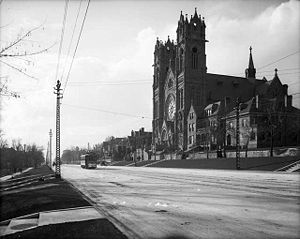

For our walkabout we explored the Avenues district while experience and photographing the architecture and landscape. We tried to experience as much of the area as possible; we visited a local park and tried to take in a variety of what the district has to offer.
The Avenues district is one of Utah's largest local historic district, and one of the most beloved residential areas in the city. It's conveniently located and diverse in both its architecture and its people. The Avenues are one of the more densely packed residential areas in the city and the architecture is unique to the area. The Avenues are primarily composed of houses, but also contains other buildings such as Churches and Schools. In the past all of the Churches in the district were affiliated with the Latter Day Saints, but currently it also contains Churches of other denominations such as the Cathedral of the Madeleine, shown below.

What are the characteristics that marked the Avenues as a district? There is such remarkable continuity in terms of architectural style, massing, color and such things. The houses are much closer to the street than in other parts of the city and sit on tiny lots right up against their neighbors. This creates an intimacy and charm to be certain, but makes it quite different from the abundance of land in suburban neighborhoods to the south. The streets are more narrow than downtown, and ideally the speed limit is slow (far too many people speed their way up to the university on avenues streets). Every block or so there is a small market or commercial building that has been converted into an artist's studio or coffee shop but that continue to be important to the fabric and texture of the neighborhood or district. Good choice!
ReplyDelete